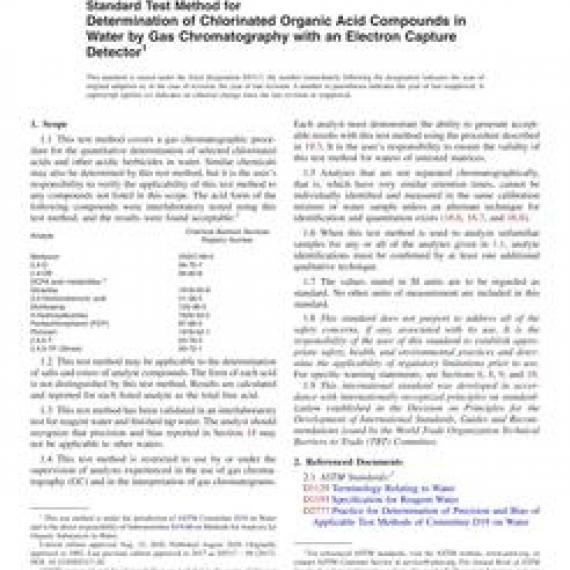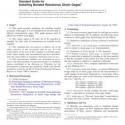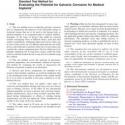No products
ASTM D5317-20
ASTM D5317-20 Standard Test Method for Determination of Chlorinated Organic Acid Compounds in Water by Gas Chromatography with an Electron Capture Detector
standard by ASTM International, 08/15/2020
Full Description
1.1This test method covers a gas chromatographic procedure for the quantitative determination of selected chlorinated acids and other acidic herbicides in water. Similar chemicals may also be determined by this test method, but it is the users responsibility to verify the applicability of this test method to any compounds not listed in this scope. The acid form of the following compounds were interlaboratory tested using this test method, and the results were found acceptable:2
| Analyte | Chemical Abstract Services |
| Bentazon | 25057-89-0 |
| 2,4-D | 94-75-7 |
| 2,4-DB | 94-82-6 |
| DCPA acid metabolites | |
| Dicamba | 1918-00-9 |
| 3,5-Dichlorobenzoic acid | 51-36-5 |
| Dichlorprop | 120-36-5 |
| 5-Hydroxydicamba | 7600-50-2 |
| Pentachlorophenol (PCP) | 87-86-5 |
| Picloram | 1918-02-1 |
| 2,4,5-T | 93-76-5 |
| 2,4,5-TP (Silvex) | 93-72-1 |
1.2This test method may be applicable to the determination of salts and esters of analyte compounds. The form of each acid is not distinguished by this test method. Results are calculated and reported for each listed analyte as the total free acid.
1.3This test method has been validated in an interlaboratory test for reagent water and finished tap water. The analyst should recognize that precision and bias reported in Section 18 may not be applicable to other waters.
1.4This test method is restricted to use by or under the supervision of analysts experienced in the use of gas chromatography (GC) and in the interpretation of gas chromatograms. Each analyst must demonstrate the ability to generate acceptable results with this test method using the procedure described in 19.3. It is the users responsibility to ensure the validity of this test method for waters of untested matrices.
1.5Analytes that are not separated chromatographically, that is, which have very similar retention times, cannot be individually identified and measured in the same calibration mixture or water sample unless an alternate technique for identification and quantitation exists (16.6, 16.7, and 16.8).
1.6When this test method is used to analyze unfamiliar samples for any or all of the analytes given in 1.1, analyte identifications must be confirmed by at least one additional qualitative technique.
1.7The values stated in SI units are to be regarded as standard. No other units of measurement are included in this standard.
1.8This standard does not purport to address all of the safety concerns, if any, associated with its use. It is the responsibility of the user of this standard to establish appropriate safety, health, and environmental practices and determine the applicability of regulatory limitations prior to use. For specific warning statements, see Sections 6, 8, 9, and 10.
1.9This international standard was developed in accordance with internationally recognized principles on standardization established in the Decision on Principles for the Development of International Standards, Guides and Recommendations issued by the World Trade Organization Technical Barriers to Trade (TBT) Committee.


































